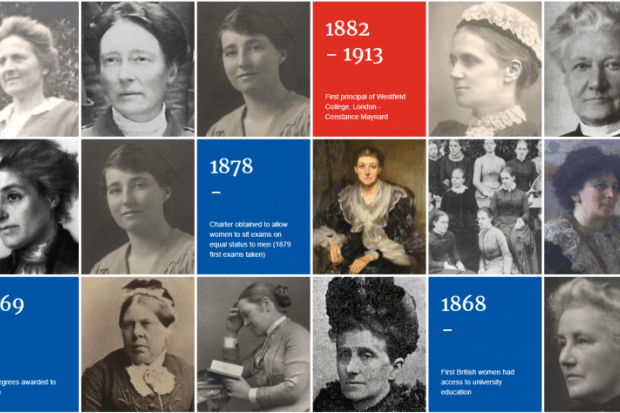At 2pm on Saturday 15 May 1869, the 17 examiners of the University of London gathered at Somerset House on the Strand. Their task that afternoon was an unusual one: to assess and grade the university’s first “General Examination for Women”, which nine candidates had sat earlier that month.
The examiners (all men) awarded honours to six of the nine women: Sarah Jane Moody, Eliza Orme, Louisa von Glehn, Kate Spiller, Isabella de Lancy West and Susannah Wood. The remaining three students – Mary Anne Belcher, Hendilah Lawrence and Mary Baker Watson – did not pass the examination. Regardless, all nine were pioneers in women’s higher education.
In June 1868, the University of London’s Senate had voted to admit women to sit the General Examination, so becoming the world’s first university to accept women.
Candidates were required to pass at least six papers across a range of subjects: Latin, English language, English history, geography, mathematics, natural philosophy, two from Greek, French, German and Italian, and either chemistry or botany. The University ruled that the General Examination would not be “on the whole less difficult than the existing Matriculation Examination”.
Despite this, unlike their male peers, on passing the General Examination successful women didn’t receive a degree but a “Certificate of Proficiency”. It would be another decade before women were admitted to the university’s degree programme, with London again the first to offer this option to female students.
Some 150 years on from that first intake, the University of London is celebrating the admission of its first nine female students, and the many thousands who have since followed.
This month, the university launched its “Leading Women” campaign at Senate House in London. The campaign, which runs during 2018 and beyond, will commemorate alumnae, celebrate contemporary female students and champion the next generation – including those young women who turn 18 in 2018.
Women’s higher education in London dates from the late 1840s, with the foundation of Bedford College by the Unitarian benefactor, Elisabeth Jesser Reid. Bedford was initially a teaching institution independent of the University of London, which was itself an examining institution, established in 1836. Over the next three decades, London University examinations were available only to male students.
Demands for women to sit examinations (and receive degrees) increased in the 1860s. After initial resistance, a compromise was reached and, in August 1868, the university announced that female students aged 17 or over would be admitted to the university to sit the new General Examination for Women.
Of those first nine women who took the exam, several went on to distinguished careers. Louise Hume von Glehn (1850-1936) became a campaigner for working women and a writer of popular histories, which were published under her married name, Louise Hume Creighton. Eliza Orme (1848-1937) went on to a law degree, a successful legal career and was active in the suffrage and prison reform movements. Known for her pragmatism, she later championed “sound-minded women who wear ordinary bonnets and carry medium-sized umbrellas”.
Given their commitment to education, it’s no surprise that three of the successful candidates went into teaching. Sarah Moody and her sisters established a preparatory school in Guildford, while Susannah Wood – having graduated with a BSc – taught maths in Cheltenham, Bath and Cambridge. In 1891, Wood was appointed vice-principal of the Cambridge Training College for Women that later became Hughes Hall, Cambridge. Kate Spiller returned to her native Bridgwater, in Somerset, where she too was an active member of her local school board.
Spiller was not the only candidate who travelled to London for the examinations: Susannah Wood came from Cheltenham and Sarah Moody journeyed from Hertfordshire. The potential hazards of metropolitan life did not go unnoticed. The Home Office recommended that steps be taken “to prevent the excitement…which might arise from bringing these young persons up to London for examination”, and a matron was on hand.
In truth, the Home Office need not have worried. The London Nine were characterised by an independent spirit and made their own way – professionally and personally – in adult life. Kate Spiller and Sarah Moody lived with their sisters into old age and – along with Eliza Orme and Susannah Wood – chose not to marry.
Between 1869 and 1878, more than 250 women sat the General Examination, of whom 139 passed and were awarded honours. They came from Bedford and other London colleges, as well as schools such as Cheltenham Ladies’ College. A further 40 successful candidates prepared with “private tuition”. During the 1870s, candidates arrived from across Britain, including girls’ schools in York, Liverpool, Bradford and Kendal.
Today, their successors come to London from countries across the globe, or continue to study remotely. The University of London’s International programme has more than 50,000 students worldwide on its distance learning programmes.
Their achievements will feature prominently in the Leading Women campaign. In the coming months, talks, open days, workshops and competitions will champion today’s students and encourage others to follow them in the 2020s.
The Leading Women website features a gallery of 150 notable London alumnae and staff active from the 1860s to the present day – among them Elisabeth Jesser Reid, Louise von Glehn and others who took inspiration from the London Nine.
Philip Carter is senior lecturer and head of digital at the Institute of Historical Research, University of London.
Register to continue
Why register?
- Registration is free and only takes a moment
- Once registered, you can read 3 articles a month
- Sign up for our newsletter
Subscribe
Or subscribe for unlimited access to:
- Unlimited access to news, views, insights & reviews
- Digital editions
- Digital access to THE’s university and college rankings analysis
Already registered or a current subscriber? Login







